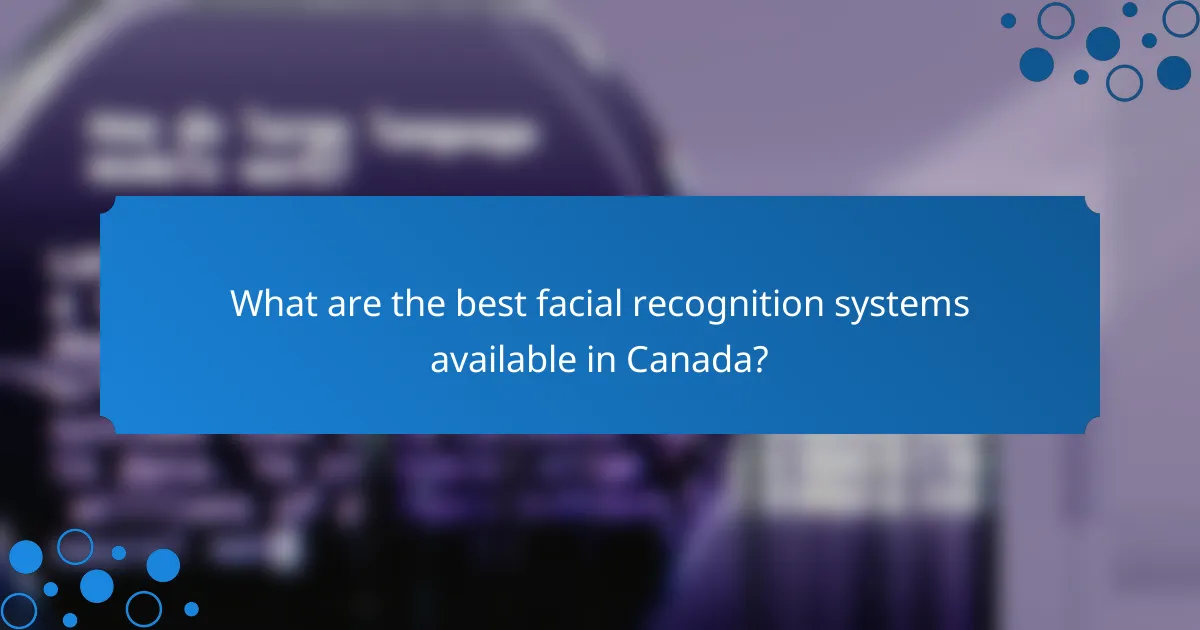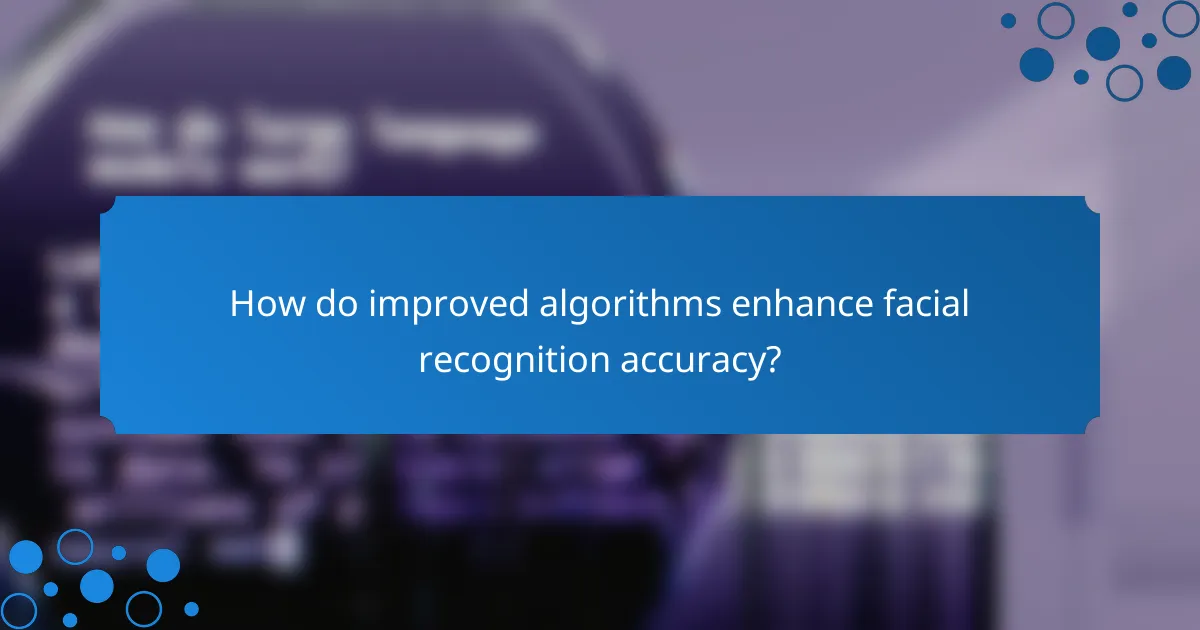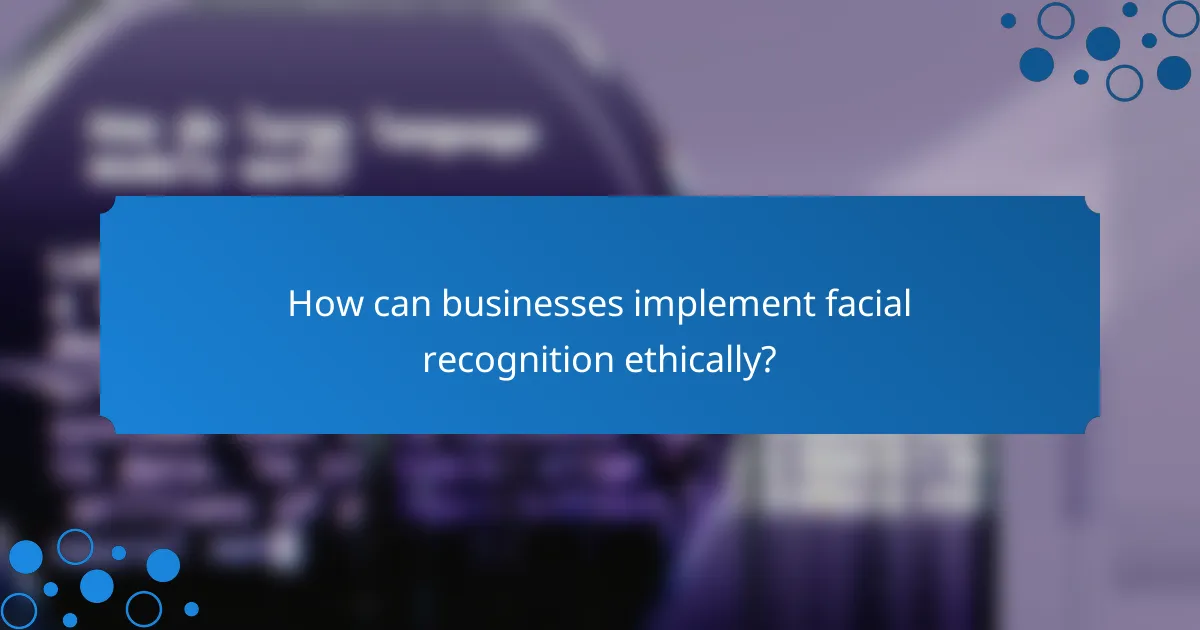Facial recognition systems have evolved significantly with improved algorithms that enhance accuracy and reliability in identifying individuals. As these technologies become more prevalent, establishing ethical guidelines and global standards is crucial to ensure responsible usage and protect individual rights. By addressing privacy concerns and promoting transparency, stakeholders can foster public trust while leveraging the benefits of advanced facial recognition capabilities.

What are the best facial recognition systems available in Canada?
In Canada, several advanced facial recognition systems are available, each with unique features and capabilities. These systems vary in performance, ease of integration, and compliance with local regulations, making it essential to evaluate them based on specific needs.
Amazon Rekognition
Amazon Rekognition is a powerful facial recognition service that offers real-time analysis and image processing. It can identify and compare faces in images and videos, making it suitable for security and surveillance applications.
This system is known for its scalability and ease of integration with other AWS services. However, users should be mindful of privacy concerns and ensure compliance with Canadian privacy laws when implementing this technology.
Microsoft Azure Face API
The Microsoft Azure Face API provides robust facial recognition capabilities, including face detection, identification, and verification. It is particularly useful for applications that require high accuracy and speed.
Azure’s service is designed to integrate seamlessly with other Microsoft Azure services, enhancing its functionality. Users should consider the costs associated with usage, which can vary based on the volume of transactions.
Face++
Face++ is a facial recognition platform that offers a range of features, including face detection, analysis, and recognition. It is known for its high accuracy and ability to process images quickly.
This system is particularly popular in various industries, including finance and security. Users should evaluate its compliance with Canadian regulations and consider the implications of data storage and processing.
Clearview AI
Clearview AI specializes in facial recognition technology that allows users to identify individuals by comparing images against a vast database sourced from publicly available online images. This system is often used by law enforcement agencies.
While it offers powerful identification capabilities, Clearview AI has faced scrutiny regarding privacy and ethical considerations. Organizations must weigh the benefits against potential legal and reputational risks in Canada.
NEC NeoFace
NEC NeoFace is a facial recognition solution known for its high accuracy and speed, making it suitable for security and identification applications. It offers features like face detection, recognition, and tracking in real-time.
This system is widely used in various sectors, including public safety and transportation. Organizations should ensure that they have appropriate measures in place to protect personal data and comply with Canadian privacy regulations.

How do improved algorithms enhance facial recognition accuracy?
Improved algorithms significantly enhance the accuracy of facial recognition systems by utilizing advanced techniques that refine image processing and analysis. These algorithms can better identify and differentiate facial features, leading to fewer errors and higher reliability in various applications.
Deep learning techniques
Deep learning techniques, particularly convolutional neural networks (CNNs), play a crucial role in enhancing facial recognition accuracy. These networks learn hierarchical features from large datasets, allowing them to recognize complex patterns in facial images. For instance, a CNN can distinguish between subtle differences in facial expressions, which is essential for accurate identification.
When implementing deep learning, it is vital to ensure access to diverse and representative training data. This diversity helps the model generalize better across different demographics, reducing bias and improving overall performance.
Data augmentation methods
Data augmentation methods enhance facial recognition systems by artificially increasing the size and diversity of training datasets. Techniques such as rotation, scaling, and color adjustments can create variations of existing images, which helps the model learn to recognize faces under different conditions. For example, augmenting images to simulate various lighting conditions can improve recognition accuracy in real-world scenarios.
It’s important to balance augmentation techniques to avoid overfitting. Using a mix of transformations while maintaining the integrity of the original data ensures that the model remains robust and effective across various applications.
Real-time processing capabilities
Real-time processing capabilities are essential for effective facial recognition, particularly in security and surveillance applications. Enhanced algorithms can process images in low tens of milliseconds, enabling immediate identification and response. This speed is crucial in scenarios such as airport security or live monitoring, where delays can lead to significant risks.
To achieve real-time processing, systems should be optimized for hardware acceleration, utilizing GPUs or specialized chips. Additionally, ensuring efficient data flow and minimizing latency in network communications can further enhance performance in practical deployments.

What ethical guidelines govern facial recognition technology?
Ethical guidelines for facial recognition technology focus on ensuring responsible usage, protecting individual rights, and promoting transparency. These guidelines are essential for addressing privacy concerns and fostering public trust in the technology.
Transparency in data usage
Transparency in data usage requires organizations to clearly communicate how facial recognition data is collected, stored, and utilized. This includes informing individuals about the purpose of data collection and the potential consequences of its use.
For example, companies should provide accessible privacy policies that outline data handling practices. Regular audits and public reports can enhance transparency and build trust among users.
Consent requirements
Consent requirements mandate that individuals must provide explicit permission before their facial data is collected or processed. This is crucial for respecting personal autonomy and privacy rights.
Organizations should implement clear consent forms that detail what data is being collected and how it will be used. Opt-in mechanisms are preferred, ensuring individuals have control over their information.
Accountability measures
Accountability measures involve establishing frameworks to hold organizations responsible for their use of facial recognition technology. This can include regulatory oversight and the implementation of internal policies that govern data use.
Organizations should designate compliance officers and create reporting mechanisms for data breaches or misuse. Regular training for employees on ethical practices can also reinforce accountability in handling facial recognition data.

What are the global standards for facial recognition systems?
Global standards for facial recognition systems establish guidelines for accuracy, interoperability, and ethical use. These standards help ensure that facial recognition technologies are reliable and respect individuals’ rights across different jurisdictions.
ISO/IEC 19794-5
ISO/IEC 19794-5 is an international standard that specifies the data format for facial images used in biometric systems. It defines how facial images should be captured, stored, and exchanged to ensure compatibility among different systems. Adhering to this standard helps organizations achieve consistent performance and interoperability in facial recognition applications.
This standard is particularly relevant for industries like law enforcement and border control, where accurate identification is crucial. Organizations implementing facial recognition technologies should ensure their systems comply with ISO/IEC 19794-5 to facilitate smoother data sharing and enhance reliability.
NIST Facial Recognition Vendor Test
The NIST Facial Recognition Vendor Test (FRVT) evaluates the performance of facial recognition algorithms from various vendors. This test assesses factors such as accuracy, speed, and robustness against different conditions, providing a benchmark for organizations choosing facial recognition solutions. Results from the FRVT help users make informed decisions based on empirical data.
Organizations should consider using vendors that have undergone NIST testing to ensure they are selecting reliable and high-performing facial recognition systems. Regular updates and new testing rounds help maintain the relevance of performance metrics in a rapidly evolving technological landscape.
GDPR compliance
GDPR compliance is essential for organizations using facial recognition systems in the European Union. The General Data Protection Regulation mandates strict guidelines on data privacy and protection, particularly concerning biometric data. Organizations must ensure that they have a legal basis for processing facial recognition data and implement measures to protect individuals’ rights.
To comply with GDPR, organizations should conduct Data Protection Impact Assessments (DPIAs) before deploying facial recognition technologies. They must also provide transparency about data usage, obtain explicit consent from individuals, and ensure robust security measures are in place to safeguard personal data.

How can businesses implement facial recognition ethically?
Businesses can implement facial recognition ethically by prioritizing transparency, user consent, and accountability. Establishing clear guidelines and practices ensures that the technology is used responsibly and respects individual privacy rights.
Conducting impact assessments
Impact assessments are crucial for understanding the potential effects of facial recognition systems on individuals and communities. Businesses should evaluate risks related to privacy violations, bias in algorithm performance, and potential misuse of data. Regular assessments can help identify areas for improvement and ensure compliance with ethical standards.
Consider using a structured framework for these assessments, such as identifying stakeholders, evaluating the technology’s accuracy, and analyzing the implications for various demographic groups. This approach can help mitigate negative outcomes and enhance public trust.
Establishing user consent protocols
Establishing user consent protocols is essential for ethical facial recognition implementation. Businesses should ensure that users are fully informed about how their data will be used and obtain explicit consent before data collection. This transparency fosters trust and allows users to make informed decisions regarding their privacy.
Protocols should include clear communication about the purpose of data collection, how long data will be stored, and the measures taken to protect it. Regularly reviewing and updating these protocols can help align with evolving regulations and public expectations, ensuring ongoing ethical compliance.
